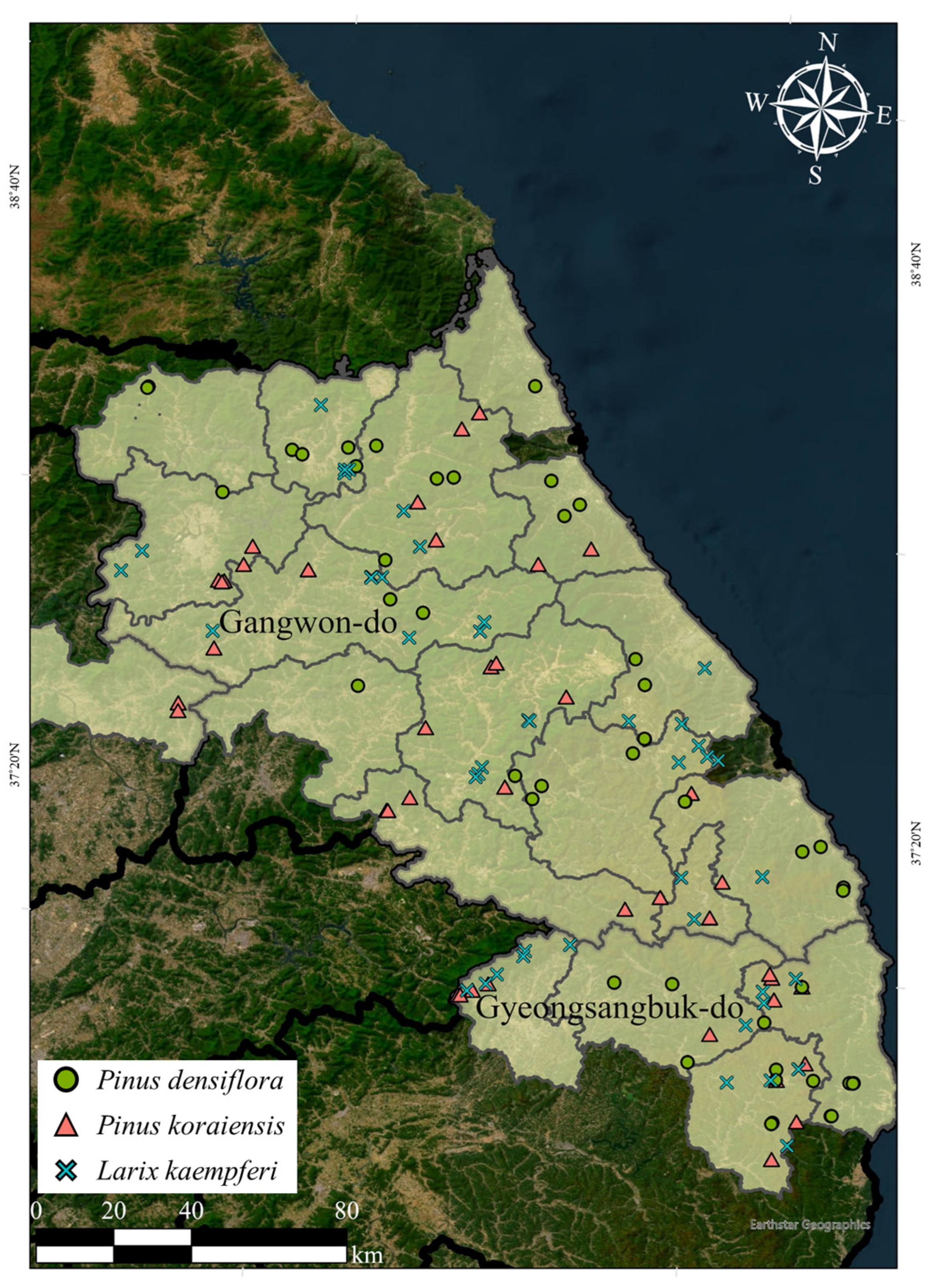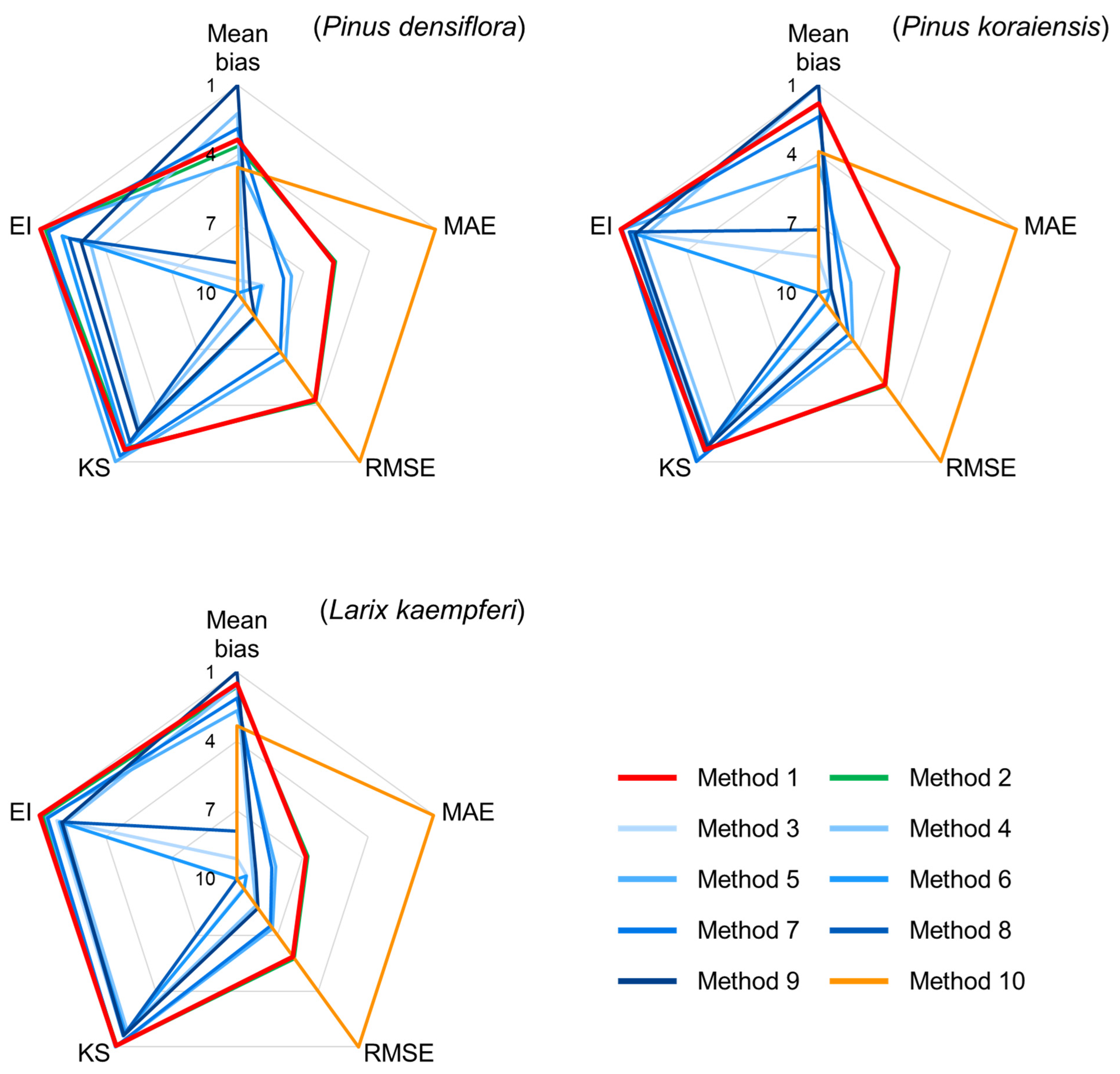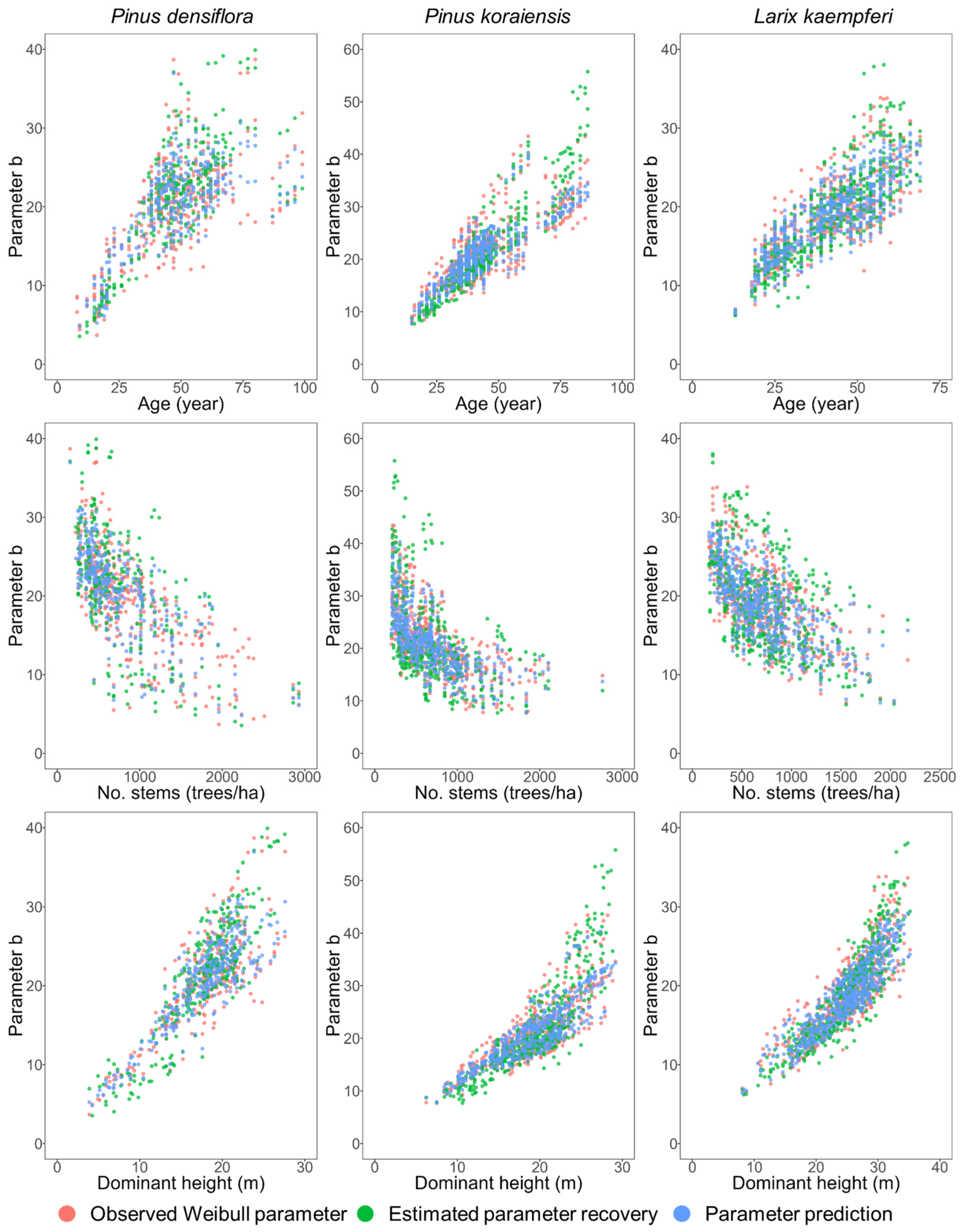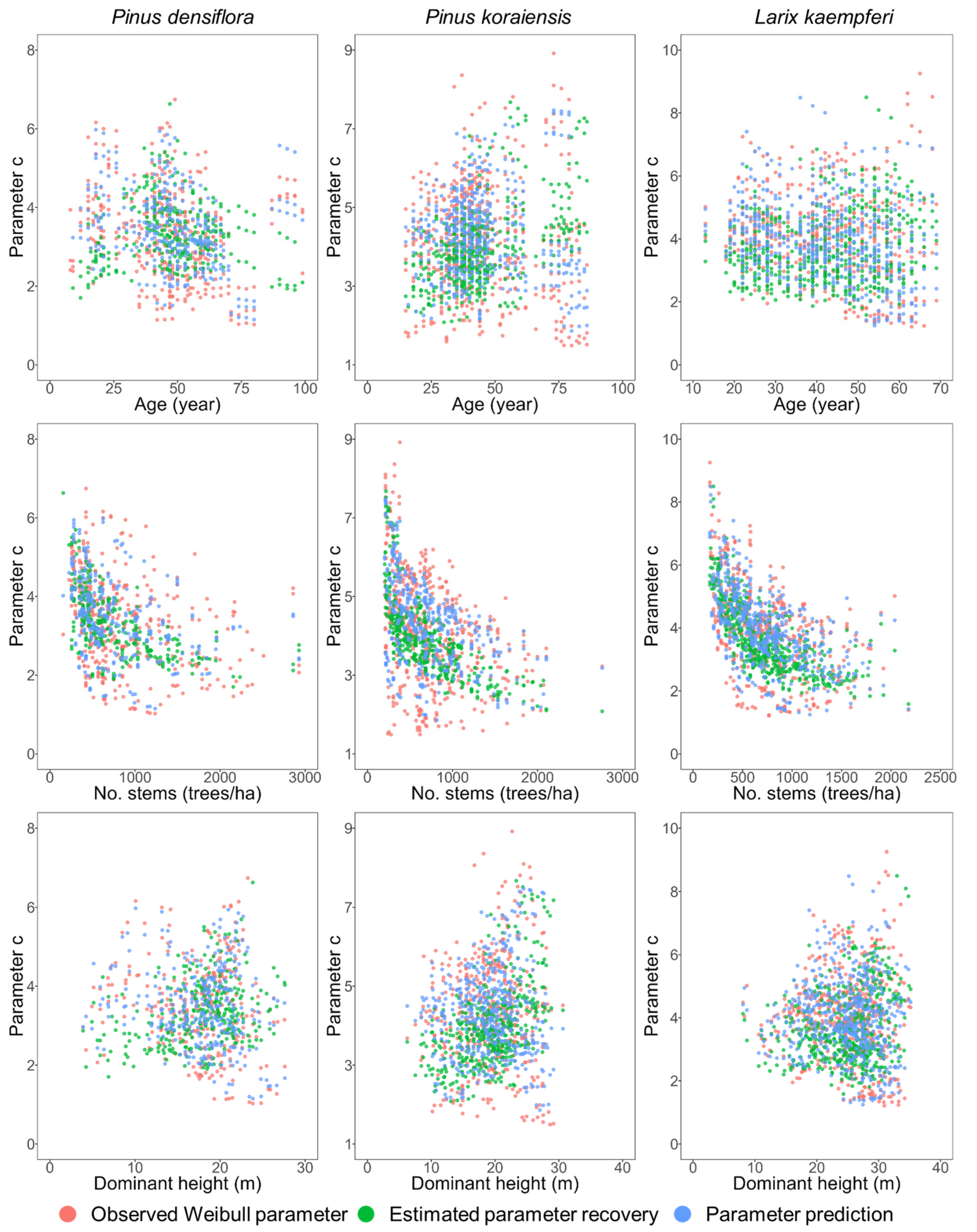Developing Diameter Distribution Models of Major Coniferous Species in South Korea
Abstract
1. Introduction
2. Materials and Methods
2.1. Data
2.2. Modeling Approach and Statistical Analysis
2.2.1. Weibull Function
2.2.2. Parameter Recovery Method
2.2.3. Estimating the Weibull Parameters
2.2.4. Model Evaluation
3. Results and Discussion
3.1. Comparison of Parameter Recovery Methods
3.2. Models for Parameter Recovery
3.3. Models for Parameter Prediction
3.4. Comparison Estimated Parameters
4. Conclusions
Supplementary Materials
Author Contributions
Funding
Data Availability Statement
Acknowledgments
Conflicts of Interest
References
- Burkhart, H.E.; Avery, T.E.; Bullock, B.P. Forest Measurements, 6th ed.; Waveland Press: Long Grove, IL, USA, 2019; ISBN 1-4786-3809-5. [Google Scholar]
- Guo, H.; Lei, X.; You, L.; Zeng, W.; Lang, P.; Lei, Y. Climate-Sensitive Diameter Distribution Models of Larch Plantations in North and Northeast China. For. Ecol. Manag. 2022, 506, 119947. [Google Scholar] [CrossRef]
- Russell, M.B.; Burkhart, H.E.; Amateis, R.L.; Prisley, S.P. Regional Locale and Its Influence on the Prediction of Loblolly Pine Diameter Distributions. South. J. Appl. For. 2012, 36, 198–203. [Google Scholar] [CrossRef]
- Lin, H.-T.; Lam, T.Y.; Peng, P.-H.; Chiu, C.-M. Embedding Boosted Regression Trees Approach to Variable Selection and Cross-Validation in Parametric Regression to Predict Diameter Distribution After Thinning. For. Ecol. Manag. 2021, 499, 119631. [Google Scholar] [CrossRef]
- Korea Forest Service. The 6th National Forest Plan (2018~2037); Korea Forest Service: Daejeon, Republic of Korea, 2018; p. 151.
- Korea Forest Service. Plant 30.9 Billion Trees by 2050 to Reduce Carbon Emissions by 34 Million Tons; Korea Forest Service: Daejeon, Republic of Korea, 2021; p. 7.
- Siipilehto, J.; Mehtätalo, L. Parameter Recovery vs. Parameter Prediction for the Weibull Distribution Validated for Scots Pine Stands in Finland. Silva Fenn. 2013, 47, 1057. [Google Scholar] [CrossRef]
- Maltamo, M.; Puumalainen, J.; Päivinen, R. Comparison of Beta and Weibull Functions for Modelling Basal Area Diameter Distribution in Stands of Pinus sylvestris and Picea abies. Scand. J. For. Res. 1995, 10, 284–295. [Google Scholar] [CrossRef]
- Cao, Q.V. Predicting Parameters of a Weibull Function for Modeling Diameter Distribution. For. Sci. 2004, 50, 682–685. [Google Scholar] [CrossRef]
- Poudel, K.P.; Cao, Q.V. Evaluation of Methods to Predict Weibull Parameters for Characterizing Diameter Distributions. For. Sci. 2013, 59, 243–252. [Google Scholar] [CrossRef]
- Liu, Y.-H.; Yen, T.-M. Combining Stand Diameter Distribution Quantified by the Weibull Function to Develop a Carbon Yield Model for Makino Bamboo (Phyllostachys makinoi Hayata). Forests 2025, 16, 436. [Google Scholar] [CrossRef]
- Siipilehto, J. Methods and Applications for Improving Parameter Prediction Models for Stand Structures in Finland. Diss. For. 2011, 124, 56. [Google Scholar] [CrossRef][Green Version]
- Korea Forest Service. 2023 Statistical Yearbook of Forestry; Korea Forest Service: Daejeon, Republic of Korea, 2023.
- Korea Forest Research Institute. Commercial Tree Species 4 Larix Kampferi; Korea Forest Research Institute: Seoul, Republic of Korea, 2012; p. 180. [Google Scholar]
- Korea Forest Research Institute. Commercial Tree Species 3 Pinus Koraiensis; Korea Forest Research Institute: Seoul, Rebublic Korea, 2012; p. 168. [Google Scholar]
- Korea Forest Research Institute. Commercial Tree Species 1 Pinus Densiflora; Korea Forest Research Institute: Seoul, Rebublic Korea, 2012; p. 250. [Google Scholar]
- Lee, D.S. Studies on Growth Models for Larix Kaempferi, Pinus Koraiensis, and Pinus Densiflora in Korea; Kangwon National University: Chuncheon, Republic of Korea, 2015. [Google Scholar]
- Jin, H.J. A Study on Model Development of Stand Growth and Adequate Thinning Criteria for Major Coniferous Species Using Stand Density Index; Kangwon National University: Chuncheon, Republic of Korea, 2024. [Google Scholar]
- Lee, D.S.; Choi, J. A study on stand structure and growth characteristics of Korean White Pine (Pinus koraiensis) in North Central Region of Gangwon Province. J. For. Environ. Sci. 2014, 30, 101–106. [Google Scholar] [CrossRef]
- Weibull, W. A Statistical Distribution Function of Wide Applicability. J. Appl. Mech. 1939, 18, 293–297. [Google Scholar] [CrossRef]
- Son, Y.M.; Pyo, J.K.; Kim, S.W.; Lee, K.H. Prediction of stand volume and carbon stock for Quercus variabilis using Weibull distribution model. J. Korean Soc. For. Sci. 2012, 101, 599–605. [Google Scholar]
- Yun, J.W. Studies on the Application of Weibull Distribution in Forestry (I)–Estimation of Diameter Distribution. J. Korean For. Soc. 1983, 59, 46–50. [Google Scholar]
- Lee, S.J. A Study on the Management of Pinus densiflora Forests by Spatial Scale to Prevent the Spread of Crown Fires; Kongju National University: Gongju, Republic of Korea, 2022. [Google Scholar]
- Lee, Y.J.; Coble, D.W. New Diameter Distribution Model for Unmanaged Loblolly Pine Plantations in East Texas. South. J. Appl. For. 2006, 30, 13–20. [Google Scholar] [CrossRef]
- Cao, Q.V.; Burkhart, H.E.; Lemin, R.C. Diameter Distributions and Yields of Thinned Loblolly Pine Plantations; Virginia Tech: Blacksburg, VA, USA, 1982. [Google Scholar]
- Hyink, D.M.; Moser, J.W. A Generalized Framework for Projecting Forest Yield and Stand Structure Using Diameter Distributions. For. Sci. 1983, 29, 85–95. [Google Scholar]
- Lynch, T.B.; Moser, J.W. A Growth Model for Mixed Species Stands. For. Sci. 1986, 32, 697–706. [Google Scholar] [CrossRef]
- Lee, D.S. Integrated Growth and Yield Models of Pinus densiflora, Pinus koraiensis, and Larix kaempferi Stands in Korea. Ph.D. Thesis, Kangwon National University, Chuncheon, Republic of Korea, 2018. [Google Scholar]
- Knowe, S.A.; Radosevich, S.R.; Shula, R.G. Basal Area and Diameter Distribution Prediction Equations for Young Douglas-Fir Plantations with Hardwood Competition: Coast Ranges. West. J. Appl. For. 2005, 20, 77–93. [Google Scholar] [CrossRef]
- McTague, J.P.; Bailey, R.L. Compatible Basal Area and Diameter Distribution Models for Thinned Loblolly Pine Plantations in Santa Catarina, Brazil. For. Sci. 1987, 33, 43–51. [Google Scholar] [CrossRef]
- Bailey, R.L.; Burgan, T.M.; Jokela, E.J. Fertilized Midrotation-Aged Slash Pine Plantations—Stand Structure and Yield Prediction Models. South. J. Appl. For. 1989, 13, 76–80. [Google Scholar] [CrossRef]
- Brooks, J.R.; Borders, B.E.; Bailey, R.L. Predicting Diameter Distributions for Site-Prepared Loblolly and Slash Pine Plantations. South. J. Appl. For. 1992, 16, 130–133. [Google Scholar] [CrossRef]
- Coble, D.W.; Lee, Y.J. A New Diameter Distribution Model for Unmanaged Slash Pine Plantations in East Texas. South. J. Appl. For. 2008, 32, 89–94. [Google Scholar] [CrossRef]
- Jiang, L.; Brooks, J.R. Predicting Diameter Distributions for Young Longleaf Pine Plantations in Southwest Georgia. South. J. Appl. For. 2009, 33, 25–28. [Google Scholar] [CrossRef]
- Lee, S.J.; Kim, S.Y.; Lee, B.D.; Lee, Y.J. Estimation of canopy fuel characteristics for Pinus densiflora stands using diameter distribution models: Forest managed stands and unmanaged stands. J. Korean Soc. For. Sci. 2018, 107, 412–421. [Google Scholar] [CrossRef]
- Poudel, K.P. Evaluation of Methods to Predict Weibull Parameters for Characterizing Diameter Distributions; Louisiana State University and Agricultural and Mechanical College: Baton Rouge, LA, USA, 2011. [Google Scholar]
- Siipilehto, J. Local Prediction of Stand Structure Using Linear Prediction Theory in Scots Pine-Dominated Stands in Finland. Silva Fenn. 2011, 45, 669–692. [Google Scholar] [CrossRef]
- Eid, T. Models for Prediction of Basal Area Mean Diameter and Number of Trees for Forest Stands in South-Eastern Norway. Scand. J. For. Res. 2001, 16, 467–479. [Google Scholar] [CrossRef]
- Lee, D.; Siipilehto, J.; Beuker, E.; Fahlvik, N.; Liziniewicz, M.; Hynynen, J. Multivariate Mixed-Effects Models for Stand Characteristics of Hybrid Aspen Plantations in Southern Finland and Southern Sweden. For. Ecol. Manag. 2023, 541, 121066. [Google Scholar] [CrossRef]
- Xie, L.; Wang, T.; Miao, Z.; Hao, Y.; Dong, L.; Li, F. Considering Random Effects and Sampling Strategies Improves Individual Compatible Biomass Models for Mixed Plantations of Larix olgensis and Fraxinus mandshurica in Northeastern China. For. Ecol. Manag. 2023, 537, 120934. [Google Scholar] [CrossRef]
- Bronisz, K.; Mehtätalo, L. Seemingly Unrelated Mixed-Effects Biomass Models for Young Silver Birch Stands on Post-Agricultural Lands. Forests 2020, 11, 381. [Google Scholar] [CrossRef]
- Ciceu, A.; Garcia-Duro, J.; Seceleanu, I.; Badea, O. A Generalized Nonlinear Mixed-Effects Height–Diameter Model for Norway Spruce in Mixed-Uneven Aged Stands. For. Ecol. Manag. 2020, 477, 118507. [Google Scholar] [CrossRef]
- Lee, D.K.; Kwon, K.W.; Kim, J.H.; Kim, G.T. Silviculture; Hyangmunsa: Seoul, Republic of Korea, 2010. [Google Scholar]
- Lee, D.S.; Jung, S.H.; Choi, J.K. Analysis of tree growth characteristics by first and second thinning in Korean White Pine plantations. J. Korean Soc. For. Sci. 2022, 111, 150–164. [Google Scholar] [CrossRef]
- Lee, D.S.; Choi, J.K. Evaluating Maximum Stand Density and Size–Density Relationships Based on the Competition Density Rule in Korean Pines and Japanese Larch. For. Ecol. Manag. 2019, 446, 204–213. [Google Scholar] [CrossRef]
- Lee, D.S.; Beuker, E.; Viherä-Aarnio, A.; Hynynen, J. Site Index Models with Density Effect for Hybrid Aspen (Populus tremula L. × P. tremuloides Michx.) Plantations in Southern Finland. For. Ecol. Manag. 2021, 480, 118669. [Google Scholar] [CrossRef]
- Yun, J.W.; Cho, H.K. Estimating Diameter Distribution with the Weibull Distribution–Case of Korea Black Pine (Pinus thunbergii) Stands on the Eastern Sea Coast of Korea. J. Korean Soc. For. Sci. 1991, 80, 420–426. [Google Scholar]







| Species | Statistics | Age (years) | DBH (cm) | Height (m) | No. of Stems (trees per ha−1) |
|---|---|---|---|---|---|
| Pinus densiflora (n = 49) | Mean | 41 | 20.9 | 13.4 | 913 |
| SD | 20 | 10.7 | 5.2 | 571 | |
| Min | 8 | 3.2 | 0.9 | 155 | |
| Max | 108 | 82.0 | 30.1 | 3405 | |
| Pinus koraiensis (n = 54) | Mean | 40 | 24.3 | 16.1 | 809 |
| SD | 14 | 9.2 | 4.6 | 443 | |
| Min | 15 | 3.6 | 1.7 | 176 | |
| Max | 86 | 65.0 | 32.3 | 2155 | |
| Larix kampferi (n = 49) | Mean | 38 | 22.8 | 20.4 | 722 |
| SD | 13 | 8.3 | 5.9 | 374 | |
| Min | 19 | 3.4 | 3.2 | 169 | |
| Max | 69 | 63.6 | 36.7 | 2037 |
| Method | Variables to Recover the Weibull Parameters | Equations | |
|---|---|---|---|
| Moment-based | 1 | , , and | is obtained from |
| 2 | , , and | is obtained from | |
| Percentile-based | 3 | , , and | |
| 4 | , , and | ||
| 5 | , , , and | ||
| 6 | , , , and | ||
| 7 | , , , and | ||
| 8 | , , , and | ||
| 9 | , , and | is obtained from | |
| Hybrid | 10 | , , , , and | |
| Species | Method | Mean Bias | MAE | RMSE | KSq | EI |
|---|---|---|---|---|---|---|
| Pinus densiflora (n = 411) | 1 | 66.3 | 77.7 | 97.7 | 0.55 | 339.4 |
| 2 | 66.3 | 77.6 | 97.7 | 0.55 | 341.9 | |
| 3 | 66.4 | 78.5 | 98.5 | 0.55 | 349.3 | |
| 4 | 66.3 | 78.7 | 98.6 | 0.57 | 362.6 | |
| 5 | 66.3 | 78.2 | 98.1 | 0.54 | 339.9 | |
| 6 | 66.4 | 78.5 | 98.5 | 0.55 | 349.3 | |
| 7 | 66.3 | 78.3 | 98.2 | 0.54 | 343.1 | |
| 8 | 66.4 | 78.8 | 98.7 | 0.56 | 352.7 | |
| 9 | 66.2 | 78.7 | 98.5 | 0.57 | 358.0 | |
| 10 | 66.3 | 76.5 | 97.1 | 0.70 | 429.6 | |
| Pinus koraiensis (n = 554) | 1 | 57.6 | 68.4 | 84.0 | 0.51 | 278.9 |
| 2 | 57.6 | 68.4 | 84.0 | 0.51 | 279.5 | |
| 3 | 57.7 | 69.5 | 85.1 | 0.51 | 287.4 | |
| 4 | 57.6 | 69.4 | 84.9 | 0.53 | 297.9 | |
| 5 | 57.6 | 69.1 | 84.6 | 0.49 | 280.0 | |
| 6 | 57.7 | 69.4 | 85.1 | 0.52 | 289.6 | |
| 7 | 57.6 | 69.3 | 84.7 | 0.49 | 279.9 | |
| 8 | 57.6 | 69.6 | 85.2 | 0.51 | 286.2 | |
| 9 | 57.6 | 69.4 | 84.8 | 0.51 | 291.6 | |
| 10 | 57.6 | 66.6 | 82.9 | 0.78 | 449.3 | |
| Larix kaempferi (n = 537) | 1 | 61.3 | 72.0 | 87.8 | 0.50 | 286.0 |
| 2 | 61.3 | 72.0 | 87.7 | 0.50 | 288.2 | |
| 3 | 61.5 | 73.0 | 88.8 | 0.52 | 299.8 | |
| 4 | 61.3 | 72.9 | 88.6 | 0.53 | 305.8 | |
| 5 | 61.3 | 72.5 | 88.2 | 0.50 | 291.2 | |
| 6 | 61.5 | 73.1 | 88.8 | 0.52 | 302.1 | |
| 7 | 61.3 | 72.6 | 88.2 | 0.50 | 292.3 | |
| 8 | 61.5 | 73.2 | 89.0 | 0.52 | 303.4 | |
| 9 | 61.3 | 72.9 | 88.5 | 0.52 | 303.8 | |
| 10 | 61.3 | 69.7 | 86.4 | 0.79 | 446.4 |
| Species | Error Index | Kolmogorov–Smirnov Statistic Quotient | Rejection Cases, Kolmogorov–Smirnov Statistic, 10% Level | The Proportion of Rejected Cases (%) |
|---|---|---|---|---|
| Pinus densiflora (n = 411) | 339 ± 226 | 0.55 ± 0.26 | 24 | 5.8 |
| (46–1606) | (0.17–1.93) | |||
| Pinus koraiensis (n = 554) | 279 ± 161 | 0.51 ± 0.19 | 12 | 2.1 |
| (49–1482) | (0.17–1.62) | |||
| Larix kaempferi (n = 537) | 286 ± 164 | 0.50 ± 0.19 | 7 | 1.3 |
| (50–1369) | (0.15–1.78) |
| Dependent Variable | Species | Fixed Effects | n | Random Effect | Residual | R2 | RMSE | MAE | MAPE |
|---|---|---|---|---|---|---|---|---|---|
| std(u) | ) | ||||||||
| Pd | 411 | 0.1286 | 0.0716 | 0.9728 | 0.0659 | 0.0504 | 0.0167 | ||
| Pk | 554 | 0.1180 | 0.0593 | 0.9747 | 0.0556 | 0.0422 | 0.0131 | ||
| Lk | 537 | 0.0889 | 0.0639 | 0.9572 | 0.0610 | 0.0453 | 0.0144 | ||
| Pd | 411 | 0.5244 | 0.3324 | 0.8822 | 0.3067 | 0.2296 | 0.0756 | ||
| Pk | 554 | 0.5213 | 0.4215 | 0.7635 | 0.3970 | 0.2891 | 0.0931 | ||
| Lk | 537 | 0.5129 | 0.4141 | 0.7585 | 0.3970 | 0.3232 | 0.1080 | ||
| Pd | 411 | 0.3629 | 0.2556 | 0.8469 | 0.2365 | 0.1768 | 0.0908 | ||
| Pk | 554 | 0.2539 | 0.2798 | 0.7186 | 0.2650 | 0.1844 | 0.0757 | ||
| Lk | 537 | 0.2159 | 0.2896 | 0.7190 | 0.2778 | 0.2141 | 0.0909 |
| Dependent Variable | Species | Fixed Effects | n | Random Effect | Residual | R2 | RMSE | MAE | MAPE |
|---|---|---|---|---|---|---|---|---|---|
| std(u) | ) | ||||||||
| a | Pd | 411 | 0.3698 | 0.2512 | 0.8586 | 0.2319 | 0.1713 | 0.1235 | |
| Pk | 554 | 0.2547 | 0.2801 | 0.7194 | 0.2650 | 0.1844 | 0.1088 | ||
| Lk | 537 | 0.2247 | 0.2888 | 0.7256 | 0.2767 | 0.2132 | 0.1328 | ||
| b | Pd | 411 | 0.1148 | 0.0983 | 0.9374 | 0.0911 | 0.0696 | 0.0243 | |
| Pk | 554 | 0.1056 | 0.0873 | 0.9231 | 0.0822 | 0.0633 | 0.0209 | ||
| Lk | 537 | 0.0924 | 0.0901 | 0.8893 | 0.0861 | 0.0680 | 0.0234 | ||
| c | Pd | 411 | 0.2602 | 0.1693 | 0.7805 | 0.1566 | 0.1212 | 0.1967 | |
| Pk | 554 | 0.2413 | 0.1952 | 0.7032 | 0.1841 | 0.1345 | 0.1213 | ||
| Lk | 537 | 0.2000 | 0.1964 | 0.7437 | 0.1878 | 0.1505 | 0.1487 |
| Method | Species | Parameter | Mean | SD | D.F. | t-Value | Pr > |t| |
|---|---|---|---|---|---|---|---|
| Estimated parameter recovery | Pd | a | −0.241 | 2.472 | 311 | −1.72 | 0.086 |
| b | 0.643 | 3.465 | 3.28 | 0.001 | |||
| c | −0.171 | 1.382 | −2.18 | 0.030 | |||
| Pk | a | −0.159 | 2.914 | 449 | −1.16 | 0.247 | |
| b | 0.245 | 4.239 | 1.23 | 0.220 | |||
| c | −0.358 | 1.615 | −4.71 | <0.001 | |||
| Lk | a | −0.026 | 2.337 | 535 | −0.26 | 0.794 | |
| b | 0.214 | 2.801 | 1.77 | 0.077 | |||
| c | −0.311 | 1.369 | −5.25 | <0.001 | |||
| Parameter prediction | Pd | a | 0.040 | 1.398 | 311 | 0.50 | 0.615 |
| b | −0.088 | 2.013 | −0.77 | 0.439 | |||
| c | −0.009 | 0.530 | −0.31 | 0.758 | |||
| Pk | a | 0.019 | 1.941 | 449 | 0.21 | 0.837 | |
| b | −0.070 | 1.962 | −0.75 | 0.452 | |||
| c | −0.003 | 0.695 | −0.10 | 0.919 | |||
| Lk | a | 0.012 | 1.966 | 535 | 0.14 | 0.892 | |
| b | −0.102 | 1.814 | −1.30 | 0.193 | |||
| c | −0.006 | 0.770 | −0.19 | 0.850 |
Disclaimer/Publisher’s Note: The statements, opinions and data contained in all publications are solely those of the individual author(s) and contributor(s) and not of MDPI and/or the editor(s). MDPI and/or the editor(s) disclaim responsibility for any injury to people or property resulting from any ideas, methods, instructions or products referred to in the content. |
© 2025 by the authors. Licensee MDPI, Basel, Switzerland. This article is an open access article distributed under the terms and conditions of the Creative Commons Attribution (CC BY) license (https://creativecommons.org/licenses/by/4.0/).
Share and Cite
Jung, S.; Lee, D.; Choi, J. Developing Diameter Distribution Models of Major Coniferous Species in South Korea. Forests 2025, 16, 961. https://doi.org/10.3390/f16060961
Jung S, Lee D, Choi J. Developing Diameter Distribution Models of Major Coniferous Species in South Korea. Forests. 2025; 16(6):961. https://doi.org/10.3390/f16060961
Chicago/Turabian StyleJung, Sanghyun, Daesung Lee, and Jungkee Choi. 2025. "Developing Diameter Distribution Models of Major Coniferous Species in South Korea" Forests 16, no. 6: 961. https://doi.org/10.3390/f16060961
APA StyleJung, S., Lee, D., & Choi, J. (2025). Developing Diameter Distribution Models of Major Coniferous Species in South Korea. Forests, 16(6), 961. https://doi.org/10.3390/f16060961







